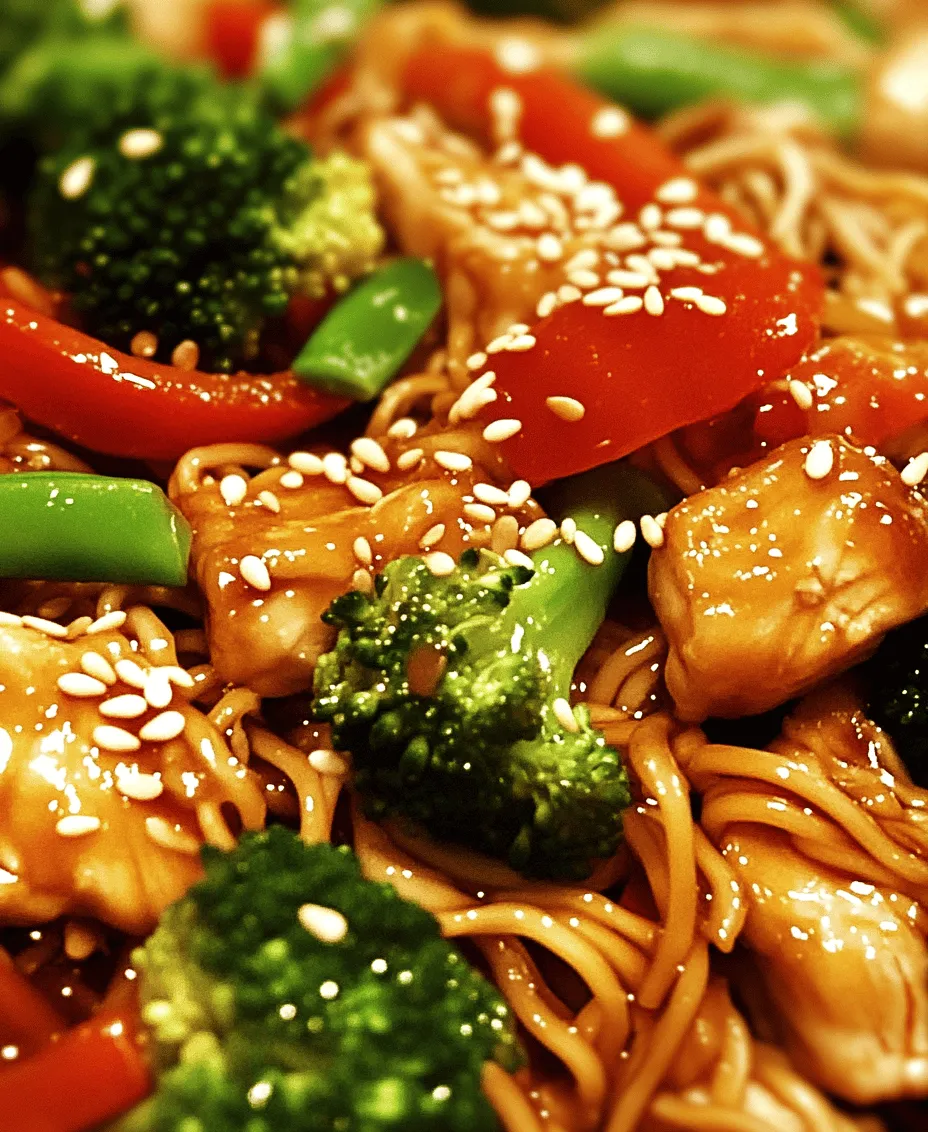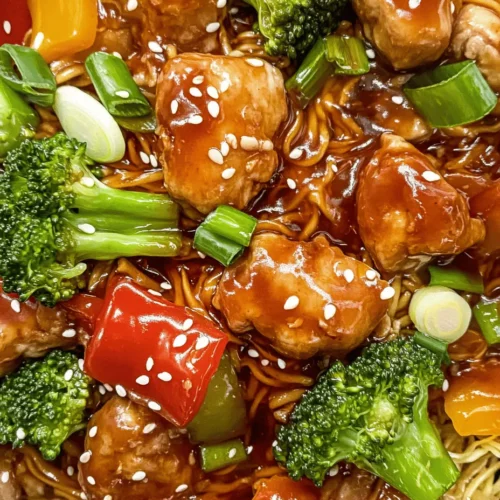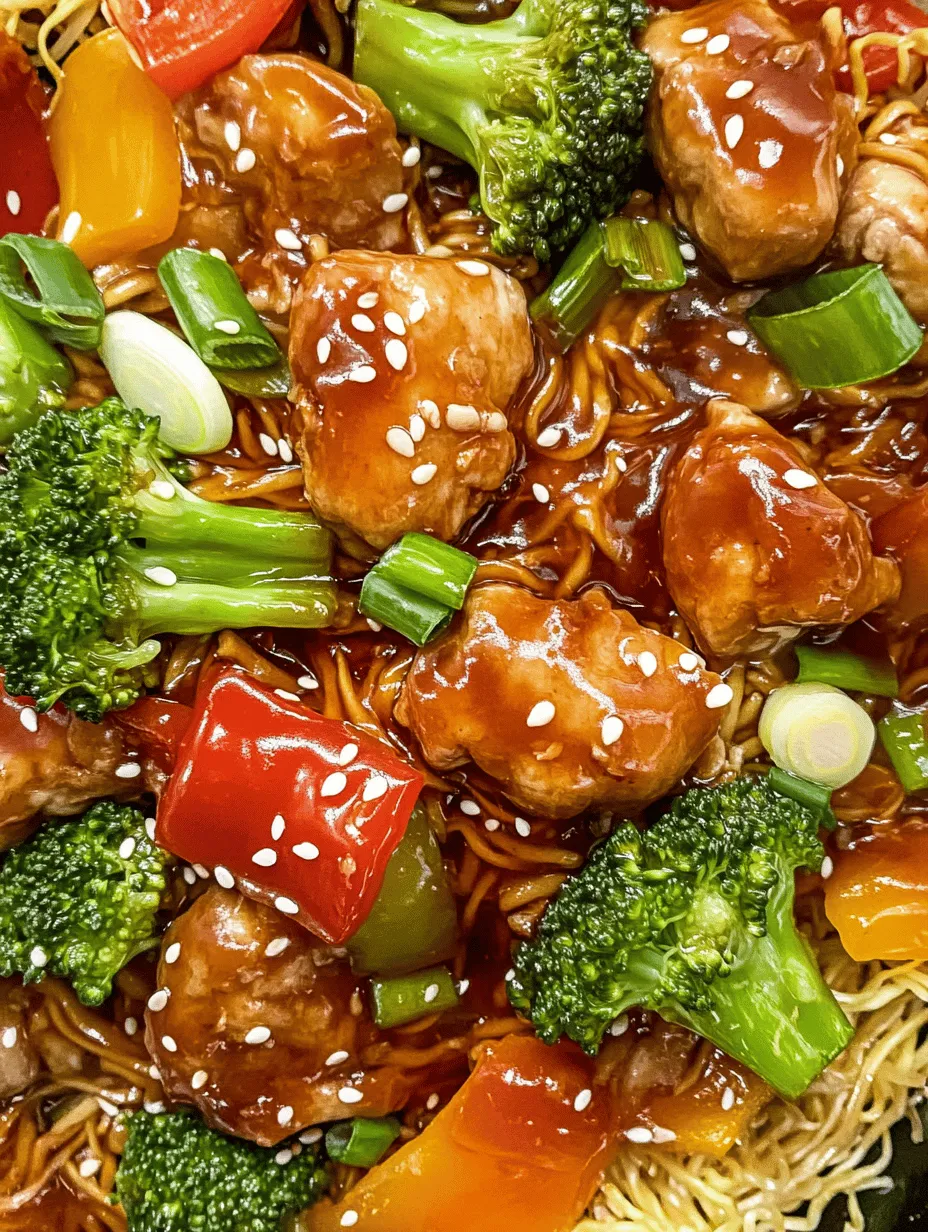Introduction
In the realm of comfort food, few dishes can compete with a vibrant plate of chow mein. This classic Chinese dish, characterized by its stir-fried noodles, tender vegetables, and succulent chicken, delivers a delightful blend of flavors and textures. Whether you’re a seasoned chef or a novice in the kitchen, this recipe for Chow Mein Bliss offers an easy yet impressive meal option that can be prepared in just 30 minutes. In this blog post, we will explore the origins of chow mein, the nutritional benefits of its ingredients, and provide a detailed breakdown of how to create this ultimate chicken delight.
Chow mein is more than just a meal; it embodies the spirit of Chinese cuisine, connecting generations through its rich history and adaptability. As we delve into this culinary gem, you’ll discover how its simplicity and versatility make it a favorite in homes and restaurants alike. With a myriad of flavor combinations and cooking techniques, chow mein has become a staple not only in its native land but also across the globe.
The Origins of Chow Mein
Chow mein, which translates to “stir-fried noodles,” has roots that trace back to the late 19th century in China. Originally, the dish was a street food, enjoyed by laborers who needed a quick and filling meal. The foundational elements of chow mein—noodles, vegetables, and proteins—were easily accessible and provided a nutritious option for those on the go.
As Chinese immigrants traveled to different parts of the world, they brought their culinary traditions with them. Chow mein began to evolve, adapting to local tastes and ingredient availability. In the United States, for example, chow mein became popularized in the early 20th century, often featuring a thicker, crispy noodle texture and a unique blend of sauces that catered to American palates. Today, you can find countless variations of chow mein, from the classic Cantonese-style to more modern interpretations that incorporate diverse ingredients.
The cultural significance of chow mein in Chinese cuisine cannot be overstated. It is a dish that reflects the principles of balance and harmony in cooking—combining different textures and flavors to create a satisfying meal. Whether served at family gatherings, street food stalls, or upscale restaurants, chow mein continues to be a beloved dish that symbolizes the richness of Chinese culinary culture.
Nutritional Benefits of Chow Mein
When it comes to nutrition, chow mein stands out as a well-rounded meal option. One of its primary ingredients, chicken, serves as an excellent source of lean protein, which is essential for muscle growth and repair. Incorporating chicken into your diet can help maintain a healthy weight and support overall well-being.
The vegetables in chow mein also play a crucial role in enhancing its nutritional profile. Packed with vitamins, minerals, and antioxidants, vegetables such as bell peppers, carrots, and broccoli contribute to a balanced diet. These colorful additions not only provide essential nutrients but also add vibrant flavors and textures that elevate the dish. Additionally, the variety of vegetables used in chow mein allows for versatility, catering to different dietary preferences and needs. Whether you’re looking to increase your vegetable intake or adapt the dish for vegetarian or gluten-free diets, chow mein can easily accommodate various dietary restrictions.
Moreover, chow mein can be a great way to incorporate leftover ingredients into a delicious meal. With its adaptable nature, you can use whatever protein or vegetables you have on hand, reducing food waste while creating a delightful dish.
Ingredients for Chow Mein Bliss
To create the ultimate chicken chow mein, it’s important to gather quality ingredients that not only enhance the flavor but also contribute to the overall texture of the dish. Here’s a breakdown of the key ingredients you’ll need:
1. Noodles: The backbone of chow mein, you can use egg noodles, rice noodles, or even whole wheat noodles. Each type offers a unique texture and flavor. Egg noodles are traditional and provide a rich taste, while rice noodles are gluten-free and lighter.
2. Chicken: Opt for boneless, skinless chicken breasts or thighs. Chicken thighs add more flavor and moisture, while breasts are leaner. Marinating the chicken beforehand enhances its taste and tenderness.
3. Vegetables: A colorful mix of vegetables is essential. Common choices include bell peppers, carrots, snap peas, and cabbage. Freshness is key, so select vibrant, crisp vegetables.
4. Sauces: Soy sauce is a must, but consider adding oyster sauce, hoisin sauce, or sesame oil for depth of flavor. These sauces not only add umami but also create a beautiful sheen on the noodles.
5. Aromatics: Garlic and ginger are classic aromatics that provide a fragrant base for the dish. Fresh herbs like scallions can be used as a finishing touch.
6. Cornstarch: Often used in marinades, cornstarch helps to tenderize the chicken and gives it a slight crispy coating when stir-fried.
Understanding the Role of Each Ingredient
– Noodles: The choice of noodles significantly impacts the dish. They should be cooked al dente before stir-frying to ensure they hold their texture and don’t become mushy when combined with the other ingredients.
– Chicken: Marinating the chicken not only infuses it with flavor but also helps keep it juicy during the cooking process. A simple marinade of soy sauce, garlic, and cornstarch can work wonders.
– Vegetables: Each vegetable contributes different nutrients and flavors. For example, bell peppers add sweetness, while snap peas provide a satisfying crunch. It’s important to cut the vegetables into uniform sizes for even cooking.
– Sauces: The combination of sauces is key to achieving a well-balanced flavor profile. Soy sauce brings saltiness, oyster sauce adds richness, and sesame oil lends a nutty aroma.
– Aromatics: The foundation of a great stir-fry lies in the aromatics. Sautéing garlic and ginger releases their essential oils, creating a fragrant base that enhances the overall flavor of the dish.
– Cornstarch: This ingredient acts as a tenderizer for the chicken, creating a velvety texture. It also helps thicken the sauce, allowing it to cling to the noodles and ingredients beautifully.
Tips for Selecting Fresh Ingredients
To ensure that your chow mein is bursting with flavor, it’s crucial to select the freshest ingredients possible. Here are some tips to help you pick the best:
– Noodles: Look for fresh or dried noodles in the international aisle of your grocery store. If using dried noodles, check the expiration date to ensure quality.
– Chicken: Choose chicken that is bright pink and firm to the touch. Avoid any packages that contain excess liquid or a grayish color, as this may indicate spoilage.
– Vegetables: Select vegetables that are vibrant in color and free from blemishes or soft spots. Fresh vegetables will provide the best flavor and texture in your chow mein.
– Aromatics: Fresh garlic and ginger should be firm and aromatic. Avoid any that are sprouting or have soft spots.
Preparing the Chicken and Vegetables
Now that you have gathered your ingredients, it’s time to prepare the chicken and vegetables for your chow mein. This step is crucial for maximizing flavor and ensuring a delicious outcome.
Marinating the Chicken for Maximum Flavor
Begin by cutting your chicken into thin strips against the grain. This helps to ensure that the chicken remains tender after cooking. Next, create a simple marinade by combining soy sauce, minced garlic, grated ginger, and a teaspoon of cornstarch in a bowl.
Add the chicken strips to the marinade, ensuring they are well coated. Allow the chicken to marinate for at least 15 minutes—this not only infuses it with flavor but also helps keep it juicy during cooking. For best results, consider marinating the chicken for up to an hour in the refrigerator, allowing the flavors to penetrate deeply.
While the chicken marinates, prepare your vegetables. Wash and chop them into bite-sized pieces, aiming for uniform sizes to ensure even cooking. The vibrant colors of the vegetables will add visual appeal to your dish and increase its nutritional value.
Preparing the Stir-Fry
Once your chicken has marinated and your vegetables are prepped, you’ll be ready to start cooking. The stir-frying process is quick, so it’s essential to have all your ingredients ready to go before you begin.
First, heat a large wok or skillet over medium-high heat. Add a tablespoon of oil, such as vegetable or peanut oil, which has a high smoke point and is ideal for stir-frying. Once the oil is hot, add the marinated chicken to the pan in a single layer. Allow it to sear without stirring for a minute or two, which helps to develop a lovely golden crust.
After the chicken is cooked through and no longer pink, remove it from the pan and set it aside. In the same pan, add a bit more oil if necessary, followed by your prepared vegetables. Stir-fry the vegetables for a few minutes until they are tender-crisp—this will help maintain their vibrant color and nutritional value.
Once the vegetables are cooked to your liking, return the chicken to the pan and add your sauces. Toss everything together, ensuring each ingredient is well coated. The final step is to add the cooked noodles, tossing them into the mixture until heated through and combined nicely with the chicken and vegetables.
With these steps carefully followed, you’ll be well on your way to creating a delightful plate of Chow Mein Bliss. Stay tuned for the next part, where we’ll dive deeper into additional tips for achieving the perfect chow mein and answer some common questions about this beloved dish.

Step-by-Step Guide to Slicing and Preparing Vegetables
Creating a delightful Chow Mein starts with the fresh and vibrant vegetables you choose. Proper preparation is key to achieving the desired texture and flavor. Here’s how to slice and prepare your vegetables:
1. Bell Peppers: Choose a mix of colors for visual appeal. Cut the bell peppers in half, remove the seeds, and slice them into thin strips. Aim for uniform sizes to ensure even cooking.
2. Carrots: Peel the carrots and slice them into julienne strips. For a quicker option, you can use a box grater or a mandoline slicer to create thin matchsticks that will cook quickly.
3. Onions: Use yellow or red onions, depending on your taste preference. Slice them into thin half-moons. The onions should be thin enough to soften quickly in the stir-fry without losing their structure.
4. Cabbage: Thinly slice green cabbage or Napa cabbage. This will add a nice crunch and is essential for the signature texture of chow mein.
5. Green Onions: Chop the green onions into small pieces, using both the white and green parts. These will add flavor and a fresh touch at the end.
6. Garlic and Ginger: Mince fresh garlic and ginger to create a fragrant base for your stir-fry. Fresh ingredients will elevate the flavor profile of the dish significantly.
Techniques for Achieving the Perfect Stir-Fry
Stir-frying is an art that requires speed and precision. Here are some techniques to help you achieve the perfect stir-fry:
– High Heat: Use a wok or a large skillet with high heat to ensure that your ingredients cook quickly and retain their color and crunch. Preheat your pan for a couple of minutes before adding oil.
– Oil Selection: Use oils with high smoke points, such as vegetable oil or peanut oil, to prevent the oil from burning. This allows for a quick cooking time while achieving a delightful sear on your ingredients.
– Batch Cooking: Avoid overcrowding the pan. Cook your chicken and vegetables in batches. This ensures that everything gets evenly cooked and doesn’t steam, which can happen if too many ingredients are in the pan at once.
– Quick Movements: Use a spatula to keep the ingredients moving. Toss them frequently to ensure even cooking and to prevent sticking. This also helps to develop a slight char, adding depth to the flavor.
Crafting the Best Chow Mein Sauce
The sauce is a crucial component that ties all the flavors together in your Chow Mein. Let’s break down the essential ingredients and how to customize them.
1. Soy Sauce: This is the base of your sauce, providing savory umami notes. Use low-sodium soy sauce to control the saltiness.
2. Oyster Sauce: This thick, rich sauce adds a slightly sweet and earthy flavor. It’s a staple in Chinese stir-fry dishes and enhances the overall depth of your chow mein.
3. Sesame Oil: A small amount adds a nutty aroma and flavor. Use it sparingly, as it can overpower other flavors.
4. Rice Vinegar: This ingredient introduces a touch of acidity, balancing the richness of the soy and oyster sauces. Adjust the amount to taste, depending on your preference for acidity.
5. Sugar: A teaspoon of sugar can enhance the sauce’s flavor, helping to counterbalance the saltiness from the soy sauce.
6. Cornstarch: Mix cornstarch with a bit of water to create a slurry that will help thicken the sauce, giving it a glossy finish.
Tips for Adjusting the Sauce to Personal Taste Preferences
– If you prefer a sweeter sauce, add more sugar or a splash of honey.
– For a spicier kick, incorporate chili oil or fresh chilies.
– Adjust the amount of soy sauce based on your sodium preference, and consider using tamari for a gluten-free option.
Cooking Process: Step-by-Step Guide
Now that you have your ingredients and sauce ready, let’s walk through the cooking process step-by-step.
Marinating the Chicken: Timing and Techniques
1. Choose Your Chicken: Use boneless, skinless chicken breasts or thighs. Cut them into thin strips to ensure quick cooking and a tender texture.
2. Marinate: In a bowl, combine the chicken with a tablespoon of soy sauce, a teaspoon of cornstarch, and a dash of sesame oil. Allow it to marinate for at least 15-30 minutes to enhance flavor and tenderness.
Cooking the Chicken to Achieve the Perfect Texture
1. Sear the Chicken: Heat your wok or skillet over high heat and add a tablespoon of oil. Once hot, add the marinated chicken in a single layer. Avoid stirring for the first minute to allow it to sear.
2. Cook Thoroughly: Stir-fry for about 4-5 minutes until the chicken is cooked through and has a golden-brown color. Remove the chicken from the pan and set aside.
Sautéing the Vegetables: Maintaining Their Crunch and Color
1. Add More Oil: If necessary, add a bit more oil to the pan. Start with the onions, cooking for 1-2 minutes until they become translucent.
2. Add Harder Vegetables: Next, add the carrots and bell peppers. Stir-fry for about 2-3 minutes, then add the cabbage and continue cooking for another minute. The goal is to keep the vegetables vibrant and slightly crisp.
Combining Chicken, Vegetables, and Sauce for a Harmonious Blend
1. Return Chicken to the Pan: Once the vegetables are cooked, add the chicken back into the pan.
2. Add Sauce: Pour the prepared Chow Mein sauce over the chicken and vegetables. Stir quickly to coat all the ingredients evenly. Cook for another 1-2 minutes until the sauce thickens slightly and everything is heated through.
Incorporating the Noodles: Ensuring Even Distribution of Flavors
1. Prepare Noodles: Cook chow mein noodles according to package instructions. Drain and rinse them under cold water to prevent sticking.
2. Combine with Stir-Fry: Add the cooked noodles to the pan and toss everything together. Ensure the noodles are evenly coated in the sauce and mixed well with the chicken and vegetables.
Serving Suggestions and Presentation Ideas
Once your Chow Mein Bliss is complete, consider these serving suggestions to elevate your dining experience:
– Serving Style: Serve your chow mein in large bowls for a family-style meal or on individual plates for a more elegant presentation.
– Garnishing: Top each serving with a sprinkle of sesame seeds and chopped green onions for added freshness and crunch. Fresh cilantro can also enhance the dish’s appearance and flavor.
– Side Dishes: Pair your chow mein with spring rolls or dumplings for a complete Chinese meal. A side of hot and sour soup can also complement the dish beautifully.
– Beverage Pairing: For drinks, consider pairing your meal with a light lager beer or a refreshing iced tea. Both options will balance the savory flavors of the chow mein.
Conclusion
Chow Mein Bliss is more than just a meal; it’s a celebration of flavors and a testament to the versatility of stir-fried noodles. This ultimate chicken delight not only brings together a colorful array of ingredients but also provides a quick, nutritious option for any occasion. By following the steps outlined in this article, you can create a dish that not only satisfies your hunger but also impresses your family and friends. Whether you’re enjoying it on a busy weeknight or serving it at a special gathering, this chow mein recipe is sure to become a cherished favorite in your culinary repertoire. So gather your ingredients, embrace the art of stir-frying, and enjoy the delicious adventure that awaits with your homemade Chow Mein Bliss!



